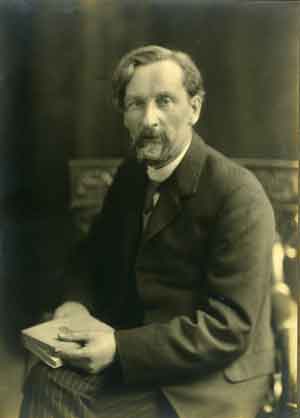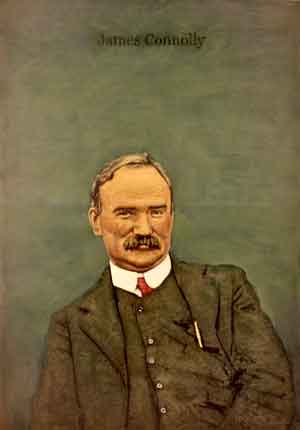By Aindrias Ó Cathasaigh

Eighty-one years after his death, William Patrick Ryan is still best remembered for editing a newspaper that was denounced by the head of the Catholic Church in Ireland but lived to tell the tale. And with good reason: even at this distance, it’s quite the feather in a radical journalist’s cap.
Returning from a successful-enough career in London newspapers, Ryan took over the Irish Peasant in Navan at the end of 1905. He intensified the paper’s focus on the social, economic and cultural revival of Ireland until it began to ruffle ecclesiastical feathers. Opposing clerical control of the Gaelic League and advocating free public libraries instead of Catholic patronage were bad enough, but calling for schools to be run by popularly elected boards rather than by the parish priest went too far. Cardinal Michael Logue branded it ‘a pernicious anti-Catholic print’ and threatened to condemn it from the altar, which was enough to scare the owner into shutting it down.
By the conventional narrative of the period, that should have been that, with nothing left for Ryan to do but run for cover and tend to his crozier wounds. It wasn’t so, however. He publicised the details of the whole affair and continued to publish The Peasant from 1907 in Dublin. It not only survived but thrived, evidencing an audience in Ireland for radical ideas prepared to defy episcopal disapproval.

THE IRISH NATION
After two successful years, the paper was renamed The Irish Nation and the Peasant at the end of 1909. It was explained to readers that the old name led many to think that it was a purely rural publication—and there was something incongruous in such a title appearing every week from the decidedly non-agricultural Temple Bar district—but the name signalled an intent to renew and broaden the message further, to tackle the whole range of issues involved in building a new Ireland.
The company behind it also had plans, with the Irish Ireland Publishing and Printing Works taking on other work. ‘The “Irish Nation” is a genuinely co-operative concern’, boasted the paper, with printers and machinists involved in its running alongside managers and journalists, and shares available to be purchased by sympathisers. Its claim to be ‘like a household’ was mirrored in the fact that Ryan and his family shared a house on Mount Street with other members of staff for a time.
A police report from 1909 describes Ryan as ‘very extreme in his views’ and as a frequent speaker ‘for the benefit of advanced political associations’. One such was Sinn Féin, a movement with which he had been in considerable sympathy, although a lecture he delivered for them—published in the last issue of The Peasant—asked ‘Has Sinn Féin a Serious Social Policy?’ and answered decidedly in the negative. The Irish Nation kept up the criticism, and published articles by people on the left of Sinn Féin who were unimpressed by Arthur Griffith’s dual-monarchy policy. Griffith’s supporters railed against what they called ‘Ryanism’ and became less favourably inclined towards the radical rival to their own paper, which briefly moved to daily publication that year.
For the last couple of years Ryan had moved steadily leftwards to an open embrace of socialism. The first issue of the Irish Nation dismissed the idea of tinkering with workers’ conditions: ‘Double the wages or halve the hours of work, and the problem would remain’. While insisting that ‘We are in no hurry ourselves to try to formulate a finished theory of socialism’, a later editorial made clear that ‘The ultimate ideal is a free, Irish-speaking, co-operative Commonwealth’.
The paper facilitated a revival taking place among Ireland’s socialists. It provided them with a platform to promote and debate their ideas—in both Irish and English—which helped to pave the way for the new Socialist Party of Ireland (Cumannacht na hÉireann), formed in 1909, a coming together of various strands on the left that was extensively reported on in the Irish Nation, which ended up becoming a kind of de facto party organ.
Ryan lectured for the Socialist Party, contending that movements in support of agricultural co-operation, civic development and especially the Irish language were moving in the direction of socialist regeneration, even unknowingly. One leading party member, William O’Brien, recorded his admiration in his diary:
‘W.P. Ryan’s Lec[ture] most inspiring I have ever heard from the standpoint of a socialist in Ireland. If it’s published in pamphlet form + gets a wide circulation it must work a revolution in the Irish workers’ minds + outlook … There was an extremely large audience—there wasn’t breathing room.’
His comrades agreed, and the party got 5,000 copies of it printed—by the Irish Ireland Printing Company. Unfortunately, Ryan’s title—Doctor Socialism and the Irish hypochondriac—puzzled many listeners and put off purchasers of the pamphlet; James Connolly later wrote that ‘The title killed the pamphlet, and nearly killed a good many poor fellows who tried to pronounce it’.
Nevertheless, Connolly was impressed by the lecture—reprinting it in his American newspaper The Harp—and by its author. He reported favourably on Ryan’s defiance of Cardinal Logue and got Ryan to write a recommendation for The Harp. In turn, Ryan gave his front page to an article in which Connolly recommended a rapprochement between socialists and left-wing Sinn Féiners, to be supported by The Harp in the US, ‘and possibly the “Irish Nation” would serve as its mouthpiece in Ireland’. (The article has since appeared in many Connolly collections, but for some reason all have omitted this concluding sentence.)
When Connolly returned to Ireland in the summer of 1910, the Irish Nation covered his activities at length and gave his writings glowing reviews. One article, a laudatory profile of him in Irish by Peadar Ó Maicín, was cut out and kept by Connolly, later to turn up among his daughter’s papers. At the start of the year Connolly had transferred The Harp to the Irish Ireland Works, but it ceased publication just before his return, leaving the Irish Nation as the sole paper of the left.
SERIOUS TROUBLE
It was little wonder that the Sligo Cathedral Calendar found the Irish Nation ‘disgusting and reprehensible’, even if calling it ‘a publication whose aims are Satanic’ rather gilded the lily. Less expected was the departure of former readers. Ryan’s left-wing lectures ‘lost the paper many friends and brought serious trouble’, he later wrote. Some believed that it was drifting from its original purpose as it increasingly espoused the socialist cause. Defying a cardinal was one thing but taking on the whole system was another matter.
And the Irish Nation had an Achilles heel that has afflicted many a radical publication: money. Ryan himself was supporting his family on two guineas a week, down from the £5 he was earning in London. Shareholders repeatedly received urgent appeals for financial assistance to keep the show on the road. Sometimes sheer luck saved it, as when Roger Casement happened to visit the office and, told that £70 was needed to stay afloat, wrote out a cheque there and then. Such guardian angels couldn’t stem the drop in sales, however, with a circulation of 9,000 at the start of 1909 falling to 5,000 by the end of the year, and to 3,000 three months later.
A ‘propaganda committee’ was established in late 1910 to save the paper. As well as Ryan, it included Connolly, O’Brien, Jim Larkin and three other socialists, three Gaelic Leaguers and two from the left of Sinn Féin—a fair reflection of where its support now lay. They came up with ambitious plans to relaunch a bigger and better paper, backed by a new company and renamed The New Nation. Ryan commended the plans in an editorial, while describing them as ‘rather ambitious’. As for himself, ‘we would not object to a holiday, and in a sanely ordered State five years of journalism would be considered quite enough for anybody’. A fortnight later, he announced that the paper would become a monthly from the start of 1911.
In fact, it didn’t last that long. The paper had noted that Charles Cooke-Taylor, prominent in the London Gaelic League, was standing for the Liberals there in the general election. It didn’t mention that he had invested in the Irish Nation to the tune of £300 and had a bill of sale against its machinery as security. All the talk about the paper’s future must have made him nervous, and he went to court to call in the debt. The propaganda committee were less than happy to have the rug pulled from under them, but there was little they could do about it. The machinery was put up for auction, and Ryan returned to London.
AFTERMATH
‘London journalism is a sphere against which I would earnestly warn young Irishmen’, wrote Ryan to the Gaelic League’s paper later in 1911. While attempting to re-establish himself in it, he wrote The pope’s green island, an intriguing look at the movements of his period back in Ireland. Bringing out the Irish Nation had been ‘arduous, exciting, and joyous … years of storm and charm’, he wrote.
When left-wingers in London established the Daily Herald in 1912, he was its first staffer, soon rising to assistant editor and occasional editor. He played an important part in the paper’s intense campaign of solidarity with the Dublin workers in the 1913 Lockout, with no grudges held over the circumstances of the Irish Nation’s demise. He remained at the Herald for the rest of his life, less happily from the 1920s on as it drifted from its radical origins.
Only months after the Irish Nation went under, the Irish Worker emerged to blaze a trail in Dublin journalism. In some ways it took up where the Irish Nation left off, with support for the language and Irish-Ireland causes. Larkin, however, edited quite a different paper, its socialism voicing a more aggressive class hatred in tandem with a movement that could put words into action. Ryan was fulsome in his praise of Larkin and Larkinism, but to some extent the Irish left was moving on. While he remained a convinced pacifist, violence came to play an increasing role in radical politics, both in Ireland and internationally. Late in life, Ryan’s unpublished memoirs lamented the fall of the Irish Nation but recognised that it might not have withstood what lay ahead:
‘It was sorely needed in days that were soon to come, most of all when intellectual and spiritual nation-building began to give way to militancy, and more was thought of the Volunteers, and then the IRA, than of thinkers, teachers and students. Against all that it would have reasoned and wrought, so I dare say that my difficulties in the new circumstances would have been even greater than they had been in the old.’
Aindrias Ó Cathasaigh lives in Dublin, and W.P. Ryan is one of the Irish-speaking socialists discussed in his book Triúr ar Chlé (Coiscéim, 2023).
Further reading
W. O’Brien, Forth the banners go: reminiscences (Dublin, 1969).
D. Ryan, Remembering Sion: a chronicle of storm and quiet (London, 1934).
W.P. Ryan, The pope’s green island (London, 1912).
W.P. Ryan, The labour revolt and Larkinism (London, 1913).
